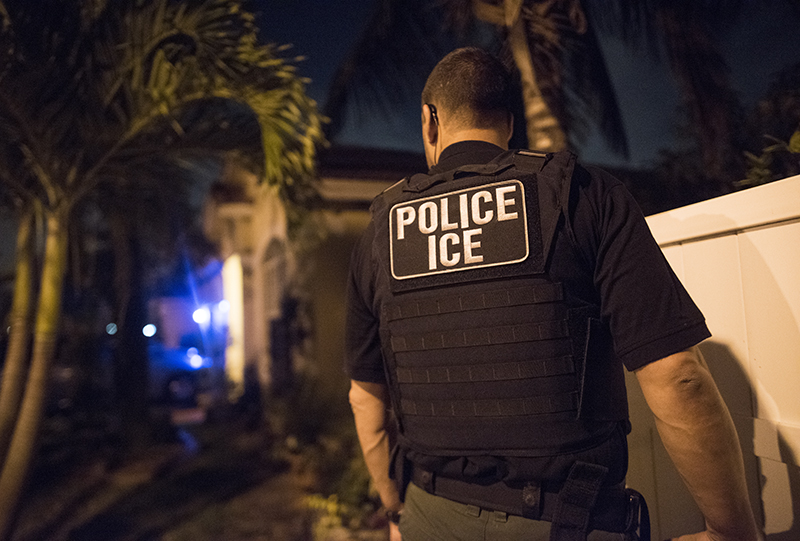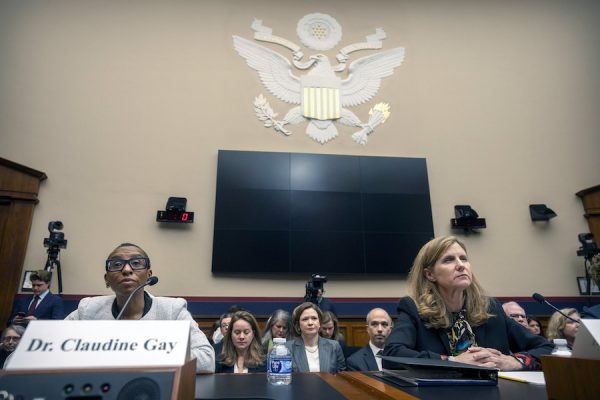As the country grapples with COVID-19, President Donald Trump is exploiting the pandemic to advance his anti-immigrant agenda, shuttering the borders and punishing migrants who are already here. The already life-threatening conditions of immigration detention have worsened, reckless deportations are spreading the virus abroad, and Trump has further gutted humanitarian relief while taking aim at legal immigration with measures that are cruel, counterproductive, and in many instances unlawful. As the economy falters, and Trump becomes increasingly worried about reelection, he will likely double down on the nativist rhetoric with which he launched his 2016 campaign. The immigrant population will disproportionately suffer as a result of the president’s botched handling of COVID-19, and the fallout of anti-immigrant policies implemented under the guise of pandemic response will surely endure long after the virus is contained.
A recent study estimates that between 72 and nearly 100 percent of people detained by ICE will be infected within 90 days.
The administration’s cruelty is jeopardizing the lives of immigrants in the custody of Immigration and Customs Enforcement (ICE). The infrastructure of immigrant detention has undergone a vast expansion under the Trump administration, and is now the largest system in the world, becoming what the ACLU has labeled Justice-Free Zones in the latest iteration of mass incarceration. As of May 9, ICE had just under 28,000 immigrants in detention in some 200 facilities across the country. The agency is authorized to detain people primarily to ensure their appearance at immigration proceedings and their availability to be deported. Despite the hyperbole about protecting citizens, however, detention is civil, not criminal, and should not be punitive. But in the midst of a pandemic, ICE’s refusal to release migrants can be a death sentence.
The Department of Homeland Security has broad authority to release migrants, and could choose to employ a host of community-based alternatives that are far more humane and cost-effective than detention. To comport with international standards, UN special rapporteur on the human rights of migrants Felipe González Morales explains that administrative immigration detention should be used as a last resort. According to him, authorities must first explore alternative measures, relying on community-based accommodation and care solutions that are less restrictive and that limit the use of immigration detention. Instead, the Trump administration instituted an assessment algorithm that dramatically reduced the number of detainees recommended for release.
Even with disaster looming in ICE facilities, the agency has resisted pleas from rights and religious groups, medical professionals, and lawmakers to release detainees, starting with those at high medical risk. So far, ICE has dragged its feet, releasing only 900 people. Advocates across the country have in response turned to the courts, securing orders to release an additional 324 vulnerable migrants. Though judges have thus far stopped short of issuing blanket orders, the dismay at ICE’s intransigence is palpable. Early in the pandemic, in ordering the release of two people in detention, federal district judge Terry J. Hatter, Jr., opined: “This is an unprecedented time in our nation’s history, filled with uncertainty, fear, and anxiety. But in the time of a crisis, our response to those at particularly high risk must be with compassion and not apathy. The Government cannot act with a callous disregard for the safety of our fellow human beings.”
That a large-scale humanitarian release of ICE detainees is a nonstarter in Washington cannot be disentangled from the fact that immigration detention is enormously profitable for Trump’s supporters. Eighty-one percent of those in immigration detention during January of this year were held in privately run, for-profit facilities. The two biggest owners of such facilities, GEO Group and CoreCivic (formerly Corrections Corporation of America), both contributed to Trump’s 2016 presidential campaign and inaugural celebration. In 2017 these companies held more than half the private detention contracts with ICE, raking in $985 million from those contracts. A 2019 report from the Department of Homeland Security’s office found egregious violations of detention standards at several facilities, yet ICE routinely fails to hold contractors accountable to its own performance standards.
Before COVID-19, detained migrants sued both GEO Group and CoreCivic to challenge forced labor practices. The pressure on detainees is even more intense under pandemic conditions, in which inflated prices for commissary goods “motivate” detained migrants to work—often for as little as a dollar a day—so they can purchase items for basic hygiene critical to avoiding infections. It is a cruel irony that the same government banning others from hiring workers without authorization circumvents these restrictions itself, and employs more undocumented workers than anyone else.
Like all carceral settings, immigrant detention centers, which are often housed in correctional facilities, are tinderboxes for disease, risking spread not only among detainees but also to those who work in the centers and the communities they return to, some of which are already straining under the pandemic. As of May 9, ICE reported 986 confirmed cases of COVID-19 among those detained, out of 2,045 people tested. This nearly 50 percent positive rate suggests that the virus is already pervasive. ICE has a disincentive to reveal the scope of spread in its facilities to avoid increasing pressure to release migrants and dodge criticism for its egregious mismanagement of the pandemic. Despite the outcry about its lax disease containment practices, ICE has continued to transfer detainees among facilities, risking further transmission.
This is a catastrophe foreseen: ICE has long been dogged by systematic failures to provide adequate health care to detained people.
ICE’s medical practices are driven not by epidemiological best practices, but instead by convenience and cost. Unchecked, this approach portends disaster. A recent study estimates that between 72 and nearly 100 percent of people detained by ICE will be infected within 90 days. More than 4,000 medical professionals signed a letter urging ICE to release migrants to stop the spread of COVID-19, noting that detention facilities “are designed to maximize control of the incarcerated population, not to minimize disease transmission or to efficiently deliver health care.” And that fact, they argue, “is compounded by often crowded and unsanitary conditions, poor ventilation, lack of adequate access to hygienic materials such as soap and water or hand sanitizers, poor nutrition, and failure to adhere to recognized standards for prevention, screening, and containment.” The lethal impacts of such lapses are already evident. Two guards in Louisiana have died of COVID-19 after ICE prohibited them from wearing masks. A Salvadoran man who had lived in the United States for 40 years died in ICE custody at the Otay Mesa facility (which currently houses 150 people who have tested positive for the virus) after being denied release by a judge despite his high risk from multiple serious medical conditions. More preventable deaths are inevitable.
This is a catastrophe foreseen: ICE has long been dogged by systematic failures to provide adequate health care to detained people. A report just released by Human Rights Watch, the ACLU, and the National Immigrant Justice Center documents pervasive and egregious preexisting flaws in the system that were exacerbated by the crisis, including understaffing and other cost-cutting measures, overcrowding, and lack of sanitary conditions. Terrified and desperate, some detainees have engaged in hunger strikes and other forms of protest, in many cases facing reprisals for speaking out, with ICE officers meting out punishment ranging from pepper spray to solitary confinement. And in an ominous reprise of its brutal family separation policies, lawyers say ICE is forcing parents to choose between indefinite detention with their children or being separated from them.
Though the United States is now the epicenter of the pandemic, the government has shown no concern for the lives of those in other countries. Indeed, throughout the COVID-19 pandemic, the United States has continued to deport migrants to countries with low reported rates of infection, while making little effort to ensure it was not exporting the virus as well. According to an analysis by Jake Johnston of the Center for Economic and Policy Research, the Trump administration likely ran 238 deportation flights to Latin American countries between February 3 and May 3. ICE claims it monitored deportees for symptoms, but had not been conducting testing, and there are confirmed cases of spread, including two dozen people deported to Colombia in April who tested positive for COVID-19, as well as sick deportees sent to Mexico, Guatemala, and Haiti. Among those slated for deportation have been detainees with known infections.
The Trump administration likely ran 238 deportation flights to Latin American countries between February 3 and May 3. ICE claims it monitored deportees for symptoms, but had not been conducting testing, and there are confirmed cases of spread.
These cases are likely only the tip of the iceberg, and threaten wider spread in countries with endemic poverty and fragile health care systems, some of which are adopting increasingly authoritarian responses to the pandemic that will only intensify the factors pushing people to flee. ICE has since said that it would acquire 2,000 tests a month to check people before deportation, far fewer than the number of monthly deportees. After 99 people deported from the United States tested positive for COVID-19, Guatemala suspended incoming flights, but the Trump administration was displeased, threatening to impose visa sanctions on countries that refuse to accept future flights of deportees. Trump later called the presidents of Honduras and El Salvador, who have continued to accept flights and acquiesce to his immigration demands, providing praise, and promising ventilators and other aid. Under intense pressure to stay in Trump’s good graces, Guatemala relented and allowed flights to resume. Since then, three more deportees have tested positive for the virus.
Trump has capitalized on the pandemic to further erode humanitarian protections he had already been systematically dismantling. Examples include the implementation of metering and the deceptively named Migrant Protection Protocols (MPP), policies that force asylum seekers to wait in Mexico under perilous conditions. A paltry 1 percent of asylum seekers in the MPP had been granted asylum by the end of January, while desperate minors who later cross the border alone are facing deportation. Last summer, under intense pressure from Trump, the presidents of Honduras, El Salvador, and Guatemala entered into controversial Asylum Cooperative Agreements, in which they agree to accept refugees who were seeking asylum in the United States—despite inadequate capacity to ensure their safety or fairly adjudicate their requests for refuge.
Notably, the vast majority of migrants at the U.S. southern border are fleeing from mayhem and deprivation in these very countries. Honduras provides a stark example of the administration’s folly. In the midst of the pandemic, Honduran president and Trump ally Juan Orlando Hernández was again linked to drug trafficking by U.S. prosecutors. Just as the charges against a former associate of Hernández were announced, the United States proclaimed its Asylum Cooperative Agreement with Honduras, allowing the United States to begin deporting non-Honduran asylum seekers there, even though the beleaguered country does not satisfy conditions to safely accept migrants, and some 76,000 Hondurans are seeking asylum elsewhere.
Using the pandemic as a pretext to shut down asylum even further, the Trump administration has used an order from the Centers for Disease Control to engage in summary expulsions of asylum seekers, an inhumane process that runs afoul of domestic and international law. Some 20,000 asylum seekers have already been expelled to Mexico, including nearly 400 minors, while only two people have been granted humanitarian relief. A coalition of public health experts have decried the move, which has been extended indefinitely.
Not satisfied with wreaking havoc on immigrants who have crossed the border without authorization, Trump issued a proclamation enacting sweeping restrictions to legal immigration under the pretense of protecting U.S. workers during the pandemic. The order is initially for sixty days and targets people outside the United States who are eligible to become legal permanent residents, a status granted in many cases based on the family-based migration that Trump has derided but had thus far been unable to curtail. White House advisor Stephen Miller, architect of Trump’s most virulently anti-immigrant policies, had long been angling to use disease as an excuse to restrict access to the country. In a leaked private call with Trump allies, Miller reportedly said, “The first and most important thing is to turn off the faucet of new immigrant labor—mission accomplished.” He added that the strategy advances a long-term vision, not merely a stopgap measure. While the directive will have little practical effect since travel is already curtailed, it scores a political win for Trump’s base, which has railed against the country’s inevitable demographic changes, and there is a real risk it will become permanent.
Trump has embraced a slate of other heartless measures aimed at immigrants as well. The administration has refused to suspend the public charge rule, which permits the government to deny permanent residency to immigrants that officials consider likely to become reliant on government benefits. Though the administration clarified that the use of certain benefits for COVID-19 testing and treatment would not be used adversely, the assurance is unlikely to assuage the fears of migrants. Immigrant neighborhoods have been hit hard by the pandemic, exacerbating already existing inequality.
Despite the fact that immigrants are overrepresented in providing essential services, they were left out of the $2 trillion CARES Act, excluding an estimated 15 million people from relief.
But despite the fact that immigrants are overrepresented in providing essential services, they were left out of the $2 trillion Coronavirus Aid, Relief, and Economic Security (CARES) Act, excluding an estimated 15 million people from relief. This decision will reverberate across borders and is compounded by the fact that undocumented immigrants are already prohibited from buying insurance coverage under the Affordable Care Act. Immigrants, including those with documentation, are disproportionately the sacrificial workers in businesses such as meatpacking plants that Trump rushed to reopen, threatening their health and that of their communities.
The president has since suggested that future coronavirus aid to states and municipalities should be withheld from Sanctuary Cities that limit law enforcement cooperation with federal immigration authorities. Just as Trump was ratcheting up his threats, the Seventh Circuit upheld an injunction blocking administration efforts to withhold funds to Sanctuary Cities. As the court held, “The executive branch has significant powers over immigration matters; the power of the purse is not one of them.”
Finally, despite lip service expressing sympathy for the plight of so-called Dreamers, Trump continues to defend in court his 2017 decision to terminate the lawful status of 800,000 immigrants granted protection under Deferred Action for Childhood Arrivals (DACA). The program provides protection from deportation and work authorization for certain children brought to the United States without authorization many years ago. Yet more than 200,000 DACA recipients are engaging in work deemed essential during the pandemic, including 29,000 health care workers. The Supreme Court’s DACA decision is imminent, and the already enormous stakes are magnified by the pandemic. As retired federal judge H. Lee Sarokin observed in the Atlantic, the Court has the opportunity to “prove to the country that despite all the hardships that surround us, humanity is not dead, cruelty does not rule the day, and compassion and empathy have not passed from the lexicon.” But as that magazine’s Adam Serwer surmised earlier in Trump’s tenure, “The Cruelty Is the Point.”
COVID-19 deaths are on the rise, the economic crisis is deepening, and Trump’s rhetoric and policy decisions are driven by fear that his reelection prospects are dimming. As the embattled president attempts to distract his base from the pandemic’s staggering toll, he will continue to center immigrants in the crosshairs. Our collective health, common humanity, and fundamental decency depend on transcending efforts to divide us and resisting the punitive nativism that Trump promotes.









